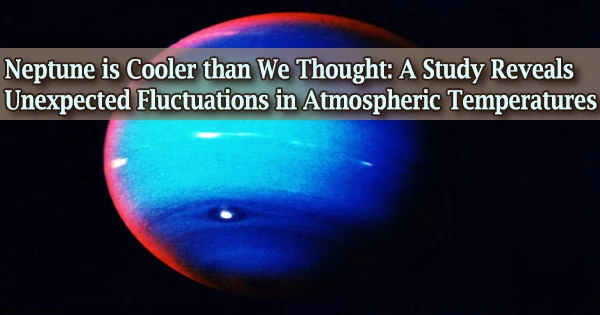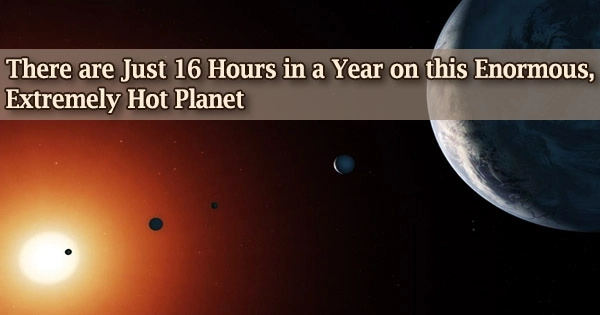Researchers at the University of Leicester have just discovered how the temperature of Neptune’s atmosphere has unpredictably changed over the previous two decades.
In order to detect heat emitted from the planet’s atmosphere, the study, which was published today (April 11, 2022) in Planetary Science Journal, utilized measurements in thermal-infrared wavelengths outside of the visible light spectrum.
All of the thermal infrared photos of Neptune that have been captured from various observatories over the past nearly two decades have been integrated by a multinational team of experts, which includes academics from Leicester and NASA’s Jet Propulsion Laboratory (JPL).
These include spectra from NASA’s Spitzer Space Telescope, as well as data from the Subaru Telescope, Keck Telescope, and Gemini North telescope in Hawaii and the Very Large Telescope and Gemini South telescope in Chile of the European Southern Observatory.
The data analysis allowed the researchers to present a more thorough picture of temperature patterns on Neptune than had previously been possible.
However, the researchers were surprised to find that these combined datasets show a decline in Neptune’s thermal brightness since reliable thermal imaging started in 2003, indicating that global average temperatures in Neptune’s stratosphere, the layer of the atmosphere directly above its active weather layer, decreased by about 8 degrees Celsius (14 degrees Fahrenheit) between 2003 and 2018.
Dr. Michael Roman, Postdoctoral Research Associate at the University of Leicester and lead author on the paper, said:
“This change was unexpected. Since we have been observing Neptune during its early southern summer, we would expect temperatures to be slowly growing warmer, not colder.”
Neptune undergoes seasons because of its axial tilt, exactly like Earth. Neptune is far from the Sun, so it takes it more than 165 years to complete an orbit around its host star. As a result, its seasons, which last more than 40 Earth years apiece, vary gradually.
Temperature variations may be related to seasonal changes in Neptune’s atmospheric chemistry, which can alter how effectively the atmosphere cools. But random variability in weather patterns or even a response to the 11-year solar activity cycle may also have an effect.
Dr. Michael Roman
Dr. Glenn Orton, Senior Research Scientist at JPL and co-author on the study, noted:
“Our data cover less than half of a Neptune season, so no one was expecting to see large and rapid changes.”
However, the findings show a separate and shockingly dramatic alteration at Neptune’s south pole. Neptune’s polar stratosphere warmed by about 11oC (~20oF) between 2018 and 2020, reversing the previous globally-averaged cooling trend, according to data from Gemini North in 2019 and Subaru in 2020.
Never before has there been such polar warming on Neptune. The results cast doubt on scientists’ knowledge of Neptune’s atmospheric variability because there is currently no known reason for these unanticipated shifts in stratospheric temperature.
Dr. Roman continued:
“Temperature variations may be related to seasonal changes in Neptune’s atmospheric chemistry, which can alter how effectively the atmosphere cools. But random variability in weather patterns or even a response to the 11-year solar activity cycle may also have an effect.”
The new study reveals a possibly, but tentative, correlation between solar activity, stratospheric temperatures, and the number of bright clouds seen on Neptune. The solar activity, stratospheric temperatures, and the 11-year solar cycle, which is characterized by periodic variation in the Sun’s activity and sunspots, have previously been proposed to affect Neptune’s visible brightness.
In the coming years, additional data of the temperature and cloud patterns will be required to assess any potential correlation.
The James Webb Space Telescope (JWST), which is scheduled to monitor both ice giants, Uranus and Neptune, later this year, will provide answers to these questions and more.
Such observations will be led by the University of Leicester professor of planetary science Leigh Fletcher during allotted instrument time on the JWST. Professor Fletcher, also a co-author on this study, said:
“The exquisite sensitivity of the space telescope’s mid-infrared instrument, MIRI, will provide unprecedented new maps of the chemistry and temperatures in Neptune’s atmosphere, helping to better identify the nature of these recent changes.”
A GIANTCLIMES funding from the European Research Council was used to pay for this study at the University of Leicester. Previous findings from this project include the first maps of the stratospheric temperatures of Uranus as well as long-term variations in the atmospheres and clouds of the gas giants Jupiter and Saturn. GIANTCLIMES has opened the door for future JWST findings on all four big planets.
Additional co-authors on this work include Thomas Greathouse (Southwest Research Institute), Julianne Moses (Space Science Institute), Naomi Rowe-Gurney (Howard University / NASA Goddard Space Flight Center), Patrick Irwin (Oxford), Arrate Antuñano (UPV/EHU), James Sinclair (JPL), Yasumasa Kasaba (Tohoku University), Takuya Fujiyoshi (Subaru Telescope), Imke de Pater (UC Berkeley), and Heidi Hammel (Association of Universities for Research in Astronomy).















